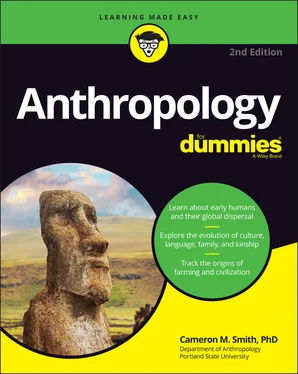Yes, We Have No Bananas: Primate Subsistence
The previous sections give you a good idea of the origins and main groups of the primates; now take a look at some details or characteristics that can help to clarify where humanity fits in as one of many primate species. I begin with subsistence in this section; later sections cover locomotion, social groups, and behavior.
Subsistence refers to how an organism fulfills its need for food, water, and nutrients. All kinds of subsistence have evolved in nature, including carnivory (eating prey animals) and herbivory (eating plant matter). Most primates basically practice omnivory , meaning that they eat wide variety of foods.
 Many anthropologists today believe that the most important factor driving the diversity of subsistence behavior in primates is food availability and distribution ; that is, what’s the distribution of food in space, and how does that distribution vary with time? Because, like any species, primates have to eat, the extent to which their foods are available from season to season has important effects on their behavior and anatomy. Some common primate responses to seasonal changes in diet include switching to different food sources, increasing the time spent in search of food, and splitting the social group to spread out the resource demand. For example, studies show that in lean times, spectral tarsiers (tiny, giant-eyed, super-cute Southeast Asian primates) spend more time traveling in search of food than they do in better times. This change affects all kinds of behavior, including conflict resulting from territorial disputes.
Many anthropologists today believe that the most important factor driving the diversity of subsistence behavior in primates is food availability and distribution ; that is, what’s the distribution of food in space, and how does that distribution vary with time? Because, like any species, primates have to eat, the extent to which their foods are available from season to season has important effects on their behavior and anatomy. Some common primate responses to seasonal changes in diet include switching to different food sources, increasing the time spent in search of food, and splitting the social group to spread out the resource demand. For example, studies show that in lean times, spectral tarsiers (tiny, giant-eyed, super-cute Southeast Asian primates) spend more time traveling in search of food than they do in better times. This change affects all kinds of behavior, including conflict resulting from territorial disputes.
The following sections take a closer look at the actual diets processed by primates.
The indiscriminate-eaters: Omnivores
Although the following sections show some exceptions, most primates are rather omnivorous, eating a variety of foods from bird eggs to leaves to seeds and even grasses, insects, tree gum, and flowers. This is in pretty stark contrast to, say crocodiles, who eat meat (fish and any vertebrate that falls into the water), or zebras, who eat only vegetation (grass and shrubs). Those animals are dietary specialists ; primates, generally speaking, are generalists . Chimpanzees, for example, eat lots of fruit, snack on termites, and occasionally hunt down small monkeys; some monkeys savor bird eggs; and gorillas live in a giant salad bowl, eating just about whatever vegetation is in reach. This dietary diversity is reflected in the nature of our versatile mouth.
The average primate mouth reflects the order’s tendency toward omnivory in the teeth. We have several kinds of teeth:
Incisors are the thin, blade-like teeth at the front of the mouth for snipping and clipping.
Canines are the pointed, conical teeth used for puncturing and light crushing; many primate species use these teeth to defend and threaten, so they’re much larger than in our species.
Premolars are the somewhat-pointed-but-somewhat-jagged teeth immediately before the molars, and they do the light crushing.
Molars are the heavy, flattish teeth in the back of the mouth that do the heavy crushing.
You can see that this multitalented mouth can process just about any food, so primates generally fall into the category of heterodont (different-teeth) rather than homodont (same-teeth). Your dog and cat are homodont — both are carnivores (at least evolutionarily) — and omnivores, such as people and pigs, are heterodont.
 Technically speaking, homodonty really means that all the teeth have the same form, as in crocodiles. Because dogs and cats (mentioned in the preceding paragraph) do have differences between their incisors and molars, for example, they’re technically heterodont. However, relatively speaking, all their teeth are for processing a meat diet, so compared to primates (who eat a more varied diet), they’re considered homodont.
Technically speaking, homodonty really means that all the teeth have the same form, as in crocodiles. Because dogs and cats (mentioned in the preceding paragraph) do have differences between their incisors and molars, for example, they’re technically heterodont. However, relatively speaking, all their teeth are for processing a meat diet, so compared to primates (who eat a more varied diet), they’re considered homodont.
 A trained anthropologist can learn an enormous amount from a single fossil tooth. Under a microscope, scratches and polishing, called dental microwear, can reveal how the jaws worked and even whether the diet was moist or dry. Knowing that it was moist or dry, in turn, can tell you something about the general conditions in which the animal survived. Extrapolations like these are used to reconstruct the lives of ancient species.
A trained anthropologist can learn an enormous amount from a single fossil tooth. Under a microscope, scratches and polishing, called dental microwear, can reveal how the jaws worked and even whether the diet was moist or dry. Knowing that it was moist or dry, in turn, can tell you something about the general conditions in which the animal survived. Extrapolations like these are used to reconstruct the lives of ancient species.
The bug-eaters: Insectivores
Insectivores eat a diet heavy in insects; this is where the primates began: as small early mammals eating small insects. Today, many primates eat a few insects — like the chimpanzees who fish termites out of their mounds by using twigs — but few focus their diet on insects, and even those who do still eat other foods such as tree gum and leaves. But for mouse lemurs and some other prosimians, insects may compose close to half the diet. The characteristics of these insectivores include
Generally very small size, normally under 100 grams (¼ pound)
A nocturnal lifestyle
Sharp teeth for processing insect bodies
An arboreal lifestyle
A short and simple digestive tract
The insectivorous primates include the African bush baby or galago, a prosimian that also eats tree gum. It has enormous ears and, unlike most primates, uses these rather than vision to locate its food sources. Weighing up to 5 kilograms (about 10 pounds), the bush baby can leap as far as 4 meters (12 feet) at a time.
The leaf-eaters: Folivores
Folivorous primates focus on eating leaves but still get plenty of variety in most of their diets — they also eat fruit and seeds if they’re available. The red howler monkey of South America dines on nearly 200 different species of plants and apparently prefers eating younger rather than more mature leaves. The most folivorous primates are characterized by the following traits:
Generally medium size (or large, compared to insectivores), averaging 5 kilograms (10 pounds)
A nocturnal lifestyle
Mixed sharp and flat teeth for processing vegetation (snipping it with the incisors, shearing it with the premolars, and then crushing it with the molars)
A long and complex digestive tract used to process vegetation
Leaves are hard to digest, so folivores’ guts are larger and more complex than those of many other primates; essentially, leaves ferment in primate stomachs. And because leaves don’t have a very high caloric content (relative to a lot of other potential foods), folivores eat a lot of them. (It takes a lot of leaves to make up a pound, which is about what some captive lemurs eat each day.) How the food is dispersed in the trees, what season it is, and how the animals get around are all linked in complex ways.
 Folivorous primates have very specialized and sensitive innards for their unique diet. Zoos often have difficulty keeping folivores healthy because they can’t supply the proper kinds of leaves. Special feeding programs have to be established to properly care for folivores, such that keepers realize they’re not just feeding the primate but also the bacterial colony in the primate’s gut that ferments the leaves.
Folivorous primates have very specialized and sensitive innards for their unique diet. Zoos often have difficulty keeping folivores healthy because they can’t supply the proper kinds of leaves. Special feeding programs have to be established to properly care for folivores, such that keepers realize they’re not just feeding the primate but also the bacterial colony in the primate’s gut that ferments the leaves.
Читать дальше

 Many anthropologists today believe that the most important factor driving the diversity of subsistence behavior in primates is food availability and distribution ; that is, what’s the distribution of food in space, and how does that distribution vary with time? Because, like any species, primates have to eat, the extent to which their foods are available from season to season has important effects on their behavior and anatomy. Some common primate responses to seasonal changes in diet include switching to different food sources, increasing the time spent in search of food, and splitting the social group to spread out the resource demand. For example, studies show that in lean times, spectral tarsiers (tiny, giant-eyed, super-cute Southeast Asian primates) spend more time traveling in search of food than they do in better times. This change affects all kinds of behavior, including conflict resulting from territorial disputes.
Many anthropologists today believe that the most important factor driving the diversity of subsistence behavior in primates is food availability and distribution ; that is, what’s the distribution of food in space, and how does that distribution vary with time? Because, like any species, primates have to eat, the extent to which their foods are available from season to season has important effects on their behavior and anatomy. Some common primate responses to seasonal changes in diet include switching to different food sources, increasing the time spent in search of food, and splitting the social group to spread out the resource demand. For example, studies show that in lean times, spectral tarsiers (tiny, giant-eyed, super-cute Southeast Asian primates) spend more time traveling in search of food than they do in better times. This change affects all kinds of behavior, including conflict resulting from territorial disputes. Technically speaking, homodonty really means that all the teeth have the same form, as in crocodiles. Because dogs and cats (mentioned in the preceding paragraph) do have differences between their incisors and molars, for example, they’re technically heterodont. However, relatively speaking, all their teeth are for processing a meat diet, so compared to primates (who eat a more varied diet), they’re considered homodont.
Technically speaking, homodonty really means that all the teeth have the same form, as in crocodiles. Because dogs and cats (mentioned in the preceding paragraph) do have differences between their incisors and molars, for example, they’re technically heterodont. However, relatively speaking, all their teeth are for processing a meat diet, so compared to primates (who eat a more varied diet), they’re considered homodont.










